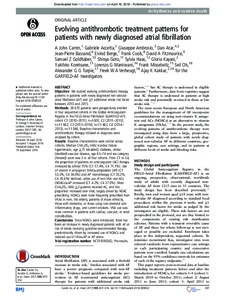Evolving antithrombotic treatment patterns for patients with newly diagnosed atrial fibrillation
Camm AJ; Accetta G; Ambrosio G; Atar D; Bassand JP; Berge E; Cools F; Fitzmaurice DA; Goldhaber SZ; Goto S; Haas S; Kayani G; Koretsune Y; Mantovani LG; Misselwitz F; Oh S; Turpie AG; Verheugt FW; Kakkar AK; GARFIELD-AF Investigators
https://urn.fi/URN:NBN:fi-fe2021042716162
Tiivistelmä
Objective We studied evolving antithrombotic therapy patterns in patients with newly diagnosed non-valvular atrial fibrillation (AF) and ≥1 additional stroke risk factor between 2010 and 2015.
Methods 39 670 patients were prospectively enrolled in four sequential cohorts in the Global Anticoagulant Registry in the FIELD-Atrial Fibrillation (GARFIELD-AF): cohort C1 (2010–2011), n=5500; C2 (2011–2013), n=11 662; C3 (2013–2014), n=11 462; C4 (2014–2015), n=11 046. Baseline characteristics and antithrombotic therapy initiated at diagnosis were analysed by cohort.
Results Baseline characteristics were similar across cohorts. Median CHA2DS2-VASc (cardiac failure, hypertension, age ≥75 (doubled), diabetes, stroke (doubled)-vascular disease, age 65–74 and sex category (female)) score was 3 in all four cohorts. From C1 to C4, the proportion of patients on anticoagulant (AC) therapy increased by almost 15% (C1 57.4%; C4 71.1%). Use of vitamin K antagonist (VKA)±antiplatelet (AP) (C1 53.2%; C4 34.0%) and AP monotherapy (C1 30.2%; C4 16.6%) declined, while use of non-VKA oral ACs (NOACs)±AP increased (C1 4.2%; C4 37.0%). Most CHA2DS2-VASc ≥2 patients received AC, and this proportion increased over time, largely driven by NOAC prescribing. NOACs were more frequently prescribed than VKAs in men, the elderly, patients of Asian ethnicity, those with dementia, or those using non-steroidal anti-inflammatory drugs, and current smokers. VKA use was more common in patients with cardiac, vascular, or renal comorbidities.
Conclusions Since NOACs were introduced, there has been an increase in newly diagnosed patients with AF at risk of stroke receiving guideline-recommended therapy, predominantly driven by increased use of NOACs and reduced use of VKA±AP or AP alone.
Kokoelmat
- Rinnakkaistallenteet [27094]
